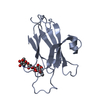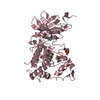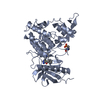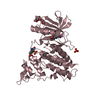Entry Database : PDB / ID : 1shwTitle EphB2 / EphrinA5 Complex Structure Ephrin type-B receptor 2 Ephrin-A5 Keywords / / / Function / homology Function Domain/homology Component
/ / / / / / / / / / / / / / / / / / / / / / / / / / / / / / / / / / / / / / / / / / / / / / / / / / / / / / / / / / / / / / / / / / / / / / / / / / / / / / / / / / / / / / / / / / / / / / / / / / / / / / / / / / / / / / / / / / / / / / / / / / / / / / / / / / / / / / / / / / / / / / / / / / / / / / / / / / / / / / / / / / / / / / / / / Biological species Mus musculus (house mouse)Method / / / Resolution : 2.2 Å Authors Himanen, J.P. / Chumley, M.J. / Lackmann, M. / Li, C. / Barton, W.A. / Jeffrey, P.D. / Vearing, C. / Geleick, D. / Feldheim, D.A. / Boyd, A.W. Journal : Nat.Neurosci. / Year : 2004Title : Repelling class discrimination: ephrin-A5 binds to and activates EphB2 receptor signalingAuthors : Himanen, J.P. / Chumley, M.J. / Lackmann, M. / Li, C. / Barton, W.A. / Jeffrey, P.D. / Vearing, C. / Geleick, D. / Feldheim, D.A. / Boyd, A.W. / Henkemeyer, M. / Nikolov, D.B. History Deposition Feb 26, 2004 Deposition site / Processing site Revision 1.0 May 18, 2004 Provider / Type Revision 1.1 Apr 29, 2008 Group Revision 1.2 Jul 13, 2011 Group / Version format complianceRevision 2.0 Jul 29, 2020 Group Advisory / Atomic model ... Advisory / Atomic model / Data collection / Derived calculations / Structure summary Category atom_site / chem_comp ... atom_site / chem_comp / entity / entity_name_com / pdbx_branch_scheme / pdbx_chem_comp_identifier / pdbx_entity_branch / pdbx_entity_branch_descriptor / pdbx_entity_branch_link / pdbx_entity_branch_list / pdbx_entity_nonpoly / pdbx_molecule_features / pdbx_nonpoly_scheme / pdbx_struct_assembly_gen / pdbx_struct_conn_angle / pdbx_unobs_or_zero_occ_residues / struct_asym / struct_conn / struct_site / struct_site_gen Item _atom_site.auth_asym_id / _atom_site.auth_seq_id ... _atom_site.auth_asym_id / _atom_site.auth_seq_id / _atom_site.label_asym_id / _chem_comp.name / _chem_comp.type / _entity.formula_weight / _entity.pdbx_description / _entity.pdbx_number_of_molecules / _entity.type / _pdbx_struct_assembly_gen.asym_id_list / _pdbx_struct_conn_angle.ptnr2_label_asym_id / _struct_conn.pdbx_leaving_atom_flag / _struct_conn.pdbx_role / _struct_conn.ptnr1_auth_asym_id / _struct_conn.ptnr1_auth_comp_id / _struct_conn.ptnr1_auth_seq_id / _struct_conn.ptnr1_label_asym_id / _struct_conn.ptnr1_label_atom_id / _struct_conn.ptnr1_label_comp_id / _struct_conn.ptnr1_label_seq_id / _struct_conn.ptnr1_symmetry / _struct_conn.ptnr2_auth_asym_id / _struct_conn.ptnr2_auth_comp_id / _struct_conn.ptnr2_auth_seq_id / _struct_conn.ptnr2_label_asym_id / _struct_conn.ptnr2_label_atom_id / _struct_conn.ptnr2_label_comp_id / _struct_conn.ptnr2_label_seq_id / _struct_conn.ptnr2_symmetry Description / Provider / Type Revision 2.1 Apr 3, 2024 Group Advisory / Data collection ... Advisory / Data collection / Database references / Refinement description / Structure summary Category chem_comp / chem_comp_atom ... chem_comp / chem_comp_atom / chem_comp_bond / database_2 / pdbx_initial_refinement_model / pdbx_unobs_or_zero_occ_residues Item / _database_2.pdbx_DOI / _database_2.pdbx_database_accessionRevision 2.2 Oct 30, 2024 Group / Category / pdbx_modification_feature
Show all Show less
 Open data
Open data Basic information
Basic information Components
Components Keywords
Keywords Function and homology information
Function and homology information
 X-RAY DIFFRACTION /
X-RAY DIFFRACTION /  SYNCHROTRON /
SYNCHROTRON /  MOLECULAR REPLACEMENT / Resolution: 2.2 Å
MOLECULAR REPLACEMENT / Resolution: 2.2 Å  Authors
Authors Citation
Citation Journal: Nat.Neurosci. / Year: 2004
Journal: Nat.Neurosci. / Year: 2004 Structure visualization
Structure visualization Molmil
Molmil Jmol/JSmol
Jmol/JSmol Downloads & links
Downloads & links Download
Download 1shw.cif.gz
1shw.cif.gz PDBx/mmCIF format
PDBx/mmCIF format pdb1shw.ent.gz
pdb1shw.ent.gz PDB format
PDB format 1shw.json.gz
1shw.json.gz PDBx/mmJSON format
PDBx/mmJSON format Other downloads
Other downloads 1shw_validation.pdf.gz
1shw_validation.pdf.gz wwPDB validaton report
wwPDB validaton report 1shw_full_validation.pdf.gz
1shw_full_validation.pdf.gz 1shw_validation.xml.gz
1shw_validation.xml.gz 1shw_validation.cif.gz
1shw_validation.cif.gz https://data.pdbj.org/pub/pdb/validation_reports/sh/1shw
https://data.pdbj.org/pub/pdb/validation_reports/sh/1shw ftp://data.pdbj.org/pub/pdb/validation_reports/sh/1shw
ftp://data.pdbj.org/pub/pdb/validation_reports/sh/1shw Links
Links Assembly
Assembly
 Components
Components
 Homo sapiens (human) / References: UniProt: O08543
Homo sapiens (human) / References: UniProt: O08543

 X-RAY DIFFRACTION / Number of used crystals: 1
X-RAY DIFFRACTION / Number of used crystals: 1  Sample preparation
Sample preparation SYNCHROTRON / Site:
SYNCHROTRON / Site:  NSLS
NSLS  / Beamline: X9A / Wavelength: 0.979 Å
/ Beamline: X9A / Wavelength: 0.979 Å Processing
Processing MOLECULAR REPLACEMENT
MOLECULAR REPLACEMENT Movie
Movie Controller
Controller















 PDBj
PDBj











